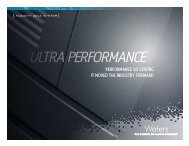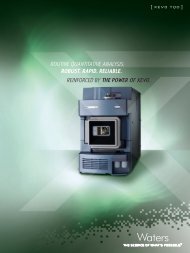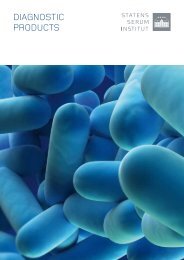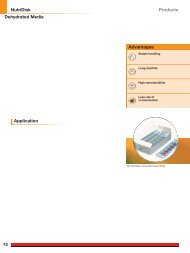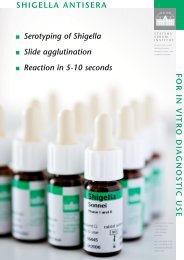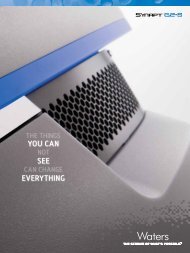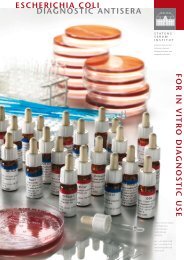You also want an ePaper? Increase the reach of your titles
YUMPU automatically turns print PDFs into web optimized ePapers that Google loves.
Media<br />
Mannitol Salt <strong>Broth</strong><br />
Products<br />
Mannitol Salt <strong>Broth</strong><br />
Used for the selective isolation and<br />
enumeration of staphylococci. In<br />
addition the medium complies with<br />
the recommendations in the United<br />
States Pharmacopeia.<br />
Description:<br />
Because of the amount of peptones<br />
and beef extract, Mannitol Salt is a<br />
nutrient rich medium. Most bacteria<br />
(other than staphylococci) are inhibited<br />
by the high concentration of sodium<br />
chloride. Organisms capable of fermenting<br />
mannitol e.g. Staphylococcus<br />
aureus, cause a pH change in the<br />
media. With phenol red as the pH<br />
indicator the colonies appear with a<br />
yellow coloration.<br />
Interpretation:<br />
Typical pathogenic staphylococci<br />
ferment mannitol and form yellow<br />
colonies with yellow zones, while<br />
typical non-pathogenic staphylococci<br />
do not ferment mannitol and form red<br />
colonies.<br />
Quality Control and recommended<br />
incubation conditions:<br />
Positive control:<br />
Staphylococcus aureus ATCC 25923,<br />
24–48 hours at 35º C.<br />
Negative control:<br />
Escherichia coli ATCC 25922,<br />
24–48 hours at 35º C.<br />
Sterility:<br />
7 days plated sterility test.<br />
Appearance of Colonies<br />
Surrounded by bright<br />
yellow zones, abundant<br />
growth<br />
pink to red colonies<br />
growth is usually poorer<br />
Microorganisms<br />
Mannitol-positive:<br />
S. aureus<br />
Mannitol-negative:<br />
S. epidermis and others<br />
Mannitol Salt <strong>Broth</strong>: Staphylococcus aureus ATCC<br />
25923 forms typical yellow colonies with zones on<br />
this media. Indication for Mannitol positive<br />
organisms.<br />
Formulation:<br />
Per liter of water adjusted<br />
to pH 7.4 ± 0.2<br />
Beef Extract<br />
Pancreatic Digest of Casein<br />
Peptic Digest of Animal Tissue<br />
Sodium Chloride<br />
d-Mannitol<br />
Phenol Red<br />
1.0 g<br />
5.0 g<br />
5.0 g<br />
75.0 g<br />
10.0 g<br />
25 mg<br />
Organisms<br />
Characteristics Coloring<br />
S. aureus ATCC 25923 Growth Yellow with<br />
yellow zones<br />
S. epidermidis ATCC 12228 Growth Red with<br />
no zone<br />
E. coli ATCC 25922 inhibited<br />
E. aerogenes ATCC 13048 inhibited<br />
Historical background:<br />
The tolerance of Staphylococcus aureus to high concentrations of sodium<br />
chloride was reported by Koch in 1942. In 1945, Chapman described a<br />
formulation which incorporated 7.5 % sodium chloride in phenol red<br />
mannitol agar to successfully cultivate pathogenic staphylococci. These<br />
coagulase positive organisms grew in large colonies surrounded by yellow<br />
zones. Non-pathogenic staphylococci are usually less luxuriant after the 36<br />
hour incubation period recommended by Chapman.<br />
Mannitol Salt <strong>Broth</strong> and Agar is recommended for the enumeration of<br />
staphylococci in food and dairy products by the American Public Health<br />
Association.<br />
Order information Mannitol Salt Media<br />
Product Description Qty/Pkg Order No<br />
Ampouled Media 2 ml 50 10 496 121<br />
Petri dishes with sterile pads 47 mm 100 10 498 544<br />
Petri dishes with sterile pads 50 mm 50 10 445 905<br />
* available on request<br />
48




